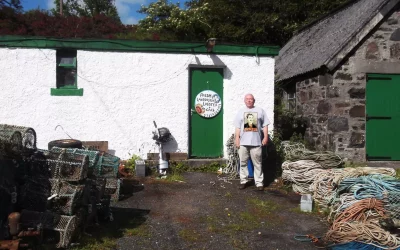Jeremy Malies on Jura: Why Jura?

There is something unpalatable and Citizen-Kane-ish about the first major building you see after landing by ferry on Jura in the Inner Hebrides. Black wrought-iron gates, the height and width of those at Versailles, stand in front of Jura House. A media-shy child retiree hedge fund manager has bought up the most traditional estate here and turned it into a golf course with hotel.
Money has always abounded on an island still owned in part by the Astors. Thirty years ago rave music pioneers KLF burnt a million pounds at a boathouse on the shoreline just beyond these gates. The money, in the form of £50 notes, was dropped into the flames from a suitcase under scrutiny that included video recording. All indications are that every one of the notes was indeed cash. Bill Drummond and Jimmy Cauty had musical pedigree but also a performative artist streak, having fired blanks from a machinegun during the Brit Awards. A wicker man had been set alight earlier in the evening here while party-goers cavorted in druid outfits on ground that has been home to real druids. Anything elsewhere on Jura has surely been tame? Well maybe not? George Orwell had already written the novel of the century at the head of the island.
This is a stretch of featherbed bog shaped like a teardrop sitting between the Sound of Jura and the Atlantic. It’s 26 miles in length and home to 200 people who coexist with 6,000 deer. Unsurprisingly, the best way to move around is by boat, a fact soon absorbed by our man. Orwell had a wooden dinghy and used a British Seagull outboard motor that gave him problems with magneto and starting plug. In 1947 he nearly drowned himself and three others in Scotland’s maelstrom, the Corryvreckan Whirlpool, when he misread his own tide timetable.
So why was he here? Orwell first visited Jura in the summer of 1944 having been invited to stay on the Astors’ Tarbert estate. The family have been major landowners on the island in the past but much of their estate has been sold off in recent years. The suggestion that Orwell should visit had come from
David Astor, editor of The Observer. Orwell subsequently spent time at a fisherman’s cottage and looked at Barnhill farmhouse, deciding to rent it for much of 1946. He made the decision partly through fear of nuclear war as he tells crime novelist Julian Symons: “If the show does start and is as bad as one fears, it would be fairly easy to be self-supporting on these islands provided one wasn’t looted.” Astor was horrified by this proposed long tenancy and neighbours were surprised when Orwell arrived with only a kettle, saucepan and typewriter.
Other reasons for being here? The thinking that the Gulf Stream makes for a warmer climate in the Hebrides is sound and Orwell had thought this through. By now he must have known that his health was compromised and the right environment might help. Ever commonsensical, he would have consulted reference books. It’s nonsense to suggest that he had a death wish or was self-martyrizing. Being 23 miles on an atrocious road-cum-track from the island’s only doctor (elderly and unlikely to make a trek) was of course unwise. Being cut off from literati – although there was a flow of visitors – offered a chance to focus on finishing Nineteen Eighty-Four.
Orwell’s pushy shabby-genteel mother, Ida, had secured a place for her son on reduced fees (as potential open scholarship material) at St Cyprian’s, a fashionable high-performing prep school in my home town of Eastbourne where many of the boys were junior lairds, the sons of Scottish aristocrats who would holiday on the islands and mainland. Christopher Hitchens thought that by coming here, Orwell may have been making up for experiences he didn’t have as a child. By now, royalties had started coming in from Animal Farm (at least £0.5m at today’s prices), money that Orwell called “fairy gold” during the final months as an ironic comment on his limited scope for spending it.
Passengers on foot or bike can take a catamaran direct to Jura from Tayvallich near Loch Sween. If you have a car or truck, the crossing is from Kennacraig to the adjacent island of Islay and then a ten-minute hop on a small council-run ferry for which there is no timetable. It’s organized on a common sense basis so don’t be surprised if you are bumped off by an agricultural vehicle. They will come back for you. There is only one road, the A846, though the ‘A’ disguises the fact that it’s single-lane with passing points. Vehicles perform minuets (etiquette is generally good) to use these. Edge too far off the road during a manoeuvre and you are likely to find yourself axel-deep in the peat bog that gives the single malt here its flavour. The road takes the shape of a fishhook before being closed to regular traffic just short of Barnhill in the north. There is no road on the western (uninhabited) Atlantic side.
The Jura Hotel in Craighouse, the sole significant settlement here, has half-timbering that smacks of mock Tudor. Soft furnishings are picked out in a light tartan that I can’t identify but isn’t that of Jura families such as the Fletchers or Campbells. A previous owner and significant estate holder, Tony Riley-Smith, hoped for increased visitors (numbers are usually healthy) in the year 1984. He bought a Land Rover for the hotel and expected to ferry Orwell enthusiasts to Barnhill. To his surprise, despite a profusion of journalists, interest from tourists proved negligible. Sales of the book worldwide surged of course.
The adjoining whisky distillery is predominantly white, boasts a single tubular chimney and has a functional Le Corbusier feel. The building is hard by the fishing harbour which in Orwell’s day would have been the dock for the “steamer” or mailboat. Everything is in gleaming whitewash that sets off the palette in front of me. This ranges from dolly-mixture-pink buoys to water the colour of a Slush Puppie which is being swirled into eddies towards Cairn Pier. You could be forgiven for thinking that this scene has strayed here from a theatre or opera set.
The distillery site includes a lodge where Will Self stayed for a month as the island’s official writer in residence at the invitation of the Scottish Book Trust. Single malt might have been tame for Self; he was famously turned over by a fellow journalist who reported him for taking heroin while following John Major on the campaign jet during the 1997 election. I’ve resorted to a cheap jibe. Self is a hiker who is fond of the last stretch of the South Downs Way which comes within yards of the St Cyprian’s site in Eastbourne, and his courtesy to walking companions extends to packing a second set of waterproofs for them in case they are ill-prepared. I should be lucky to have him with me here and he would be interesting company as he is an Orwell sceptic. He has done much close reading and admires the novels but takes issue with Orwell’s views on plain writing, believing that adherence to the rules would set English prose in aspic.
I don’t think Orwell was much of a whisky drinker (he and his sister had nightly tots of rum or brandy) at Barnhill though I believe I once saw a letter – I can’t track it down – in which he asked for whisky to be sent from the mainland. Childhood companion Jacintha Buddicom recalled that as an adolescent he made a whisky still that prompted an enraged servant to hand in her notice. Even if he didn’t drink the stuff, he would have wanted a supply for local passersby and his own visitors. This isn’t coals to Newcastle as the distillery (founded in 1810) closed down in 1901 and would not reopen until the 1960s. It now produces 2.3 million litres a year and visitors can take a 40-minute tour. Orwell did drink whisky occasionally and as a young man he got tanked on it in the hope of being locked up for the night during one of his social experiments for Down and Out in Paris and London. I should have liked to have shared a cell with him drunk or sober.


